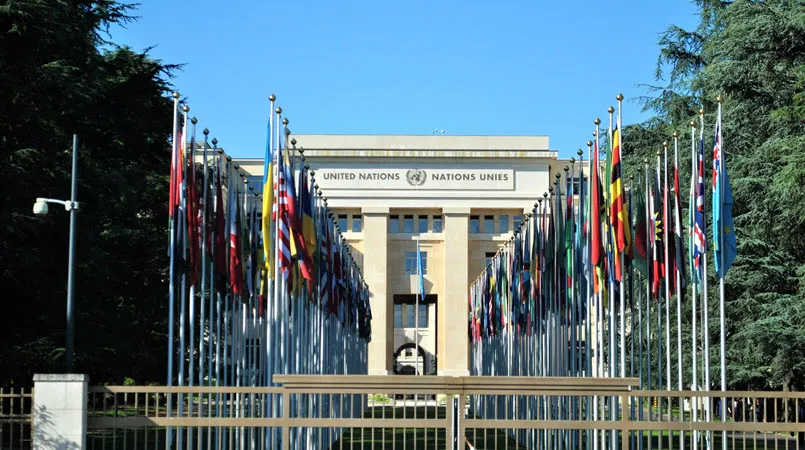Table of Contents
- Plans to Address Climate Change
- The 1.5 Deg C Temperature Ceiling
- Lack of Consensus on Fossil Fuel Phasedown
- Establishment of a Loss and Damage Fund
- The Link Between Biodiversity and Climate Change
- ISSB Updates
- Partnership Agreement
- International Cooperation and Ongoing Standards Alignment Efforts
- Main Takeaways from COP27
- ESG is Here to Stay
- ESG is About More than GHGs
- You Can’t Manage What You Can’t Measure
- Let VelocityEHS Help!
By Phil Molé, MPH
From November 6 to November 20, the 27th Conference of the Parties to the United Nations Framework Convention on Climate Change (COP27) took place in Sharm el-Sheikh, Egypt.
The purpose of the annual conference is for stakeholders to assess progress in addressing climate change and assess the need for additional actions and policies. While most of the conference attendees are representatives of governments and regulatory and standards setting bodies, there has been increasing private sector representation in recent years, due to recognition of the urgency of addressing climate change, and the importance of Environmental, Social and Governance (ESG) to business excellence. Major developments often come out of these conferences, such as the drafting of the Paris Agreement in 2015 and the formation of the International Sustainability Standards Board (ISSB) in 2021.
Here’s a recap of some of the main themes of COP27 and some key takeaways about ESG management.
Plans to Address Climate Change
Let’s start our recap with some mixed news from the conference, regarding two individual but related issues: limited global temperature increases to 1.5 degrees Celsius (deg C) relative to the pre-industrial era, and phasedown of fossil fuel use.
The 1.5 Deg C Temperature Ceiling
For some time now, there’s been a consensus among most climate scientists that we need to keep the mean global temperature increase below 1.5 deg C to avoid the most significant and long-term impacts of climate change, including sea level rise due to melting of polar ice, and loss of coral reefs and the ecosystems including them.
There was additional urgency coming into COP27 because a research paper published in November 2021 concluded that the greenhouse gas (GHG) reduction agreements reached at last year’s conference, COP26, would be unlikely to limit the global temperature rise to 1.5 deg C or less. Dr. Andy Wiltshire, the lead author of the study, stated, “Implementing all the pledges from Glasgow would bring annual global emissions of carbon dioxide or their equivalents down to between 45 and 49 gigatonnes by 2030. But at this level there are no future pathways likely to avoid going above 1.5 deg C. To give the 1.5 deg C threshold at least a 50% chance of being met without continued exceedance, we need to see annual emissions down to around 30 gigatonnes by 2030.”
During COP27, there was broad agreement that the 1.5 deg C temperature increase limit remained an important goal. In fact, countries in the EU worked to strengthen their commitment to that goal. At one point, Antonio Guterres, the UN Secretary General said, “The 1.5 deg C target is not simply about keeping a goal alive – it’s about keeping people alive… I see the will to keep to the 1.5 deg C goal, but we must ensure that commitment is evident in the COP27 outcome.”
Lack of Consensus on Fossil Fuel Phasedown
The Secretary General’s words proved to be prescient as COP27 progressed. If the expressed commitment to the 1.5-degree temperature limit was one of the key pieces of good news from the conference, the lack of agreement on specific details about how to accomplish it was one of the major pieces of bad news.
As discussed above, research has been pointing to the insufficiency of current GHG reduction pledges to prevent passing the 1.5 deg C target. Coming into COP27, stakeholders were looking for more significant GHG reduction commitments, especially from industrial countries, and many hoped for an agreement on a fossil fuel usage phasedown.

That didn’t happen. The final conference document, the Sharm el-Sheikh Implementation Plan, doesn’t commit to a phasedown of fossil fuels, but instead mentions, in a section on “mitigation,” that it calls on parties “to accelerate the development, deployment and dissemination of technologies, and the adoption of policies, to transition towards low-emission energy systems …. including accelerating efforts (emphasis added) towards the phasedown of unabated coal power and phase-out of inefficient fossil fuel subsidies.” So, the document doesn’t commit to phasing down, but calls on parties to accelerate efforts toward the phasedown. It can’t help but remind this author of the famous words of Bart Simpson when he said, “I can’t promise that I’ll try. But I’ll try to try.”
Still, while the final conference document doesn’t provide the firm commitment many stakeholders were looking for, there’s room for optimism. The widespread acceptance of the 1.5 deg C ceiling as a viable goal provides a starting point for future negotiations to develop concrete plans to reduce GHG emissions.
Establishment of a Loss and Damage Fund
A major aim of stakeholders heading into the conference was to establish a loss and damage fund to help countries most impacted by the effects of climate change pay for infrastructure improvements, or to compensate them for past damages caused by climate-related events such as flooding or severe weather. Stakeholders have been pointing out that a global commitment to justice necessitated such a fund, because the countries that have contributed the least to climate change have been the ones most affected by it. For example, countries on the African continent contribute some of the lowest GHG emissions yet are the most vulnerable to the impacts of climate change.
The UN’s 2022 Adaptation Gap Report shows there’s a need for such a fund, because it indicates international financial flows earmarked for helping developing countries adapt to climate change are five to ten times below estimated needs and will need over US$300 billion per year by 2030.
After days of debate and negotiations, country representatives attending COP27 agreed to establish a loss and damage fund. Many commentators see the agreement to establish the fund as one of the highlights of the conference, and one of the most significant achievements since the Paris Agreement at the 2015 conference.
Though, many questions remain. There currently aren’t many specific details about the management of the fund, how a country’s government representatives could apply, or what conditions would trigger a payout. It’s also not clear where all the funding will come from, or whether the funding will be enough to meet the needs of the countries who most need it.
Still, the establishment of the fund is a very important first step. It’s a signal that countries with long industrial histories are recognizing their contributions to climate risks and are willing to establish trust and solidarity with countries most vulnerable to the effects of climate change. We’ll most likely continue to see how the fund, and the relationships necessary to sustain it, continue to evolve at future conferences.
The Link Between Biodiversity and Climate Change
November 16, 2022 was officially designated as Biodiversity Day at COP27. Stakeholders who attended the conference used the day to discuss ways to protect biodiversity and use nature and ecosystem-based solutions to counter the effects of climate change.
Ecology and environmental experts have been discussing the importance of biodiversity for decades now. This author has spent quite a bit of time reading the works of the late biologist Edward O. Wilson, who arguably did more than anyone else to popularize the notion of biodiversity and discuss the crisis of species loss. For example, Wilson argued that the loss of biodiversity was not only disastrous for ecosystems, but also robbed humankind of prime sources of beauty and knowledge – including knowledge of genetics and biological knowledge that could inform future medical breakthroughs. Insights like these have informed decades of activism and policy advocacy.
Until recently, biodiversity has been seen as a separate issue from climate change, but as Biodiversity Day at COP27 shows, that’s changing now. Stakeholders attending COP27 came armed with knowledge about the role that forests play in carbon sequestration, which in turn means that deforestation and loss of wetlands contribute to climate change. Recent ESG standards such as the European Financial Reporting Advisory Group (EFRAG) draft standard on Biodiversity and Ecosystems reflect this awareness, referencing “the ability of forests to absorb carbon and regulate climate change.”
This understanding of the interconnectedness of climate and biodiversity also explains the emerging focus, evident at COP27, of nature-based solutions, which are the use of natural features or processes to make positive environmental impacts. For example, increasing plant fauna biodiversity by planting the right kinds of trees in the right places can remove GHGs from the atmosphere, and enable progress toward the goal of keeping the global mean temperature increase below 1.5 deg C.
As four of the key architects of the Paris Agreement said in a statement, “The climate and nature agendas are entwined …Only by taking urgent action to halt and reverse the loss of nature this decade, while continuing to step up efforts to rapidly decarbonize our economies, can we hope to achieve the promise of the Paris Agreement.”
ISSB Updates
As mentioned earlier, the ISSB formed at last year’s event, COP26, for the purpose of bringing greater reliability and consolidation to ESG disclosures—and they’ve already had a busy year. The Board completed its consolidation with the Value Reporting Foundation (VRF), assumed oversight over the Sustainability Accounting Standards Board (SASB) standards, and released its first two draft standards for public consultation. During its recent meeting held on October 18-21, ISSB also made key decisions about its future priorities, including a resolution to retain disclosure requirements for all three scopes of GHGs in its Climate Standard.
ISSB still has plenty more plans in motion, and they came to COP27 to discuss them. Here’s a high-level look at the news ISSB shared at COP27.
Partnership Agreement
On November 8, ISSB chair Emmanuel Faber took the stage at COP27 to share details of the ISSB’s new Partnership Framework with more than 20 partner organizations. The framework is designed to support ESG report preparers, investors and other capital market stakeholders as they prepare to use ISSB’s ESG disclosure standards.
The partnership has the support of public and private organizations from around the world, including Environmental Resources Management (ERM); European Accounting Association, Global Reporting Initiative (GRI); Global Steering Group for Impact Investment (GSGII); Group of Latin American Accounting Standard Setters (GLASS); International Corporate Governance Network (ICGN); International Federation of Accountants (IFAC); the UK Foreign, Commonwealth & Development Office (FCDO); the UN Department of Economic and Social Affairs (UNDESA); the UNDP-Financial Centres for Sustainability (FC4S) and the World Business Council for Sustainable Development (WBCSD) CFO Network.
ISSB intends that the partnership will improve implementation of its standards, with a focus on the specific circumstances of smaller entities and emerging and developing economies.
International Cooperation and Ongoing Standards Alignment Efforts
ISSB stated that they are working with the European Commission and EFRAG toward a shared objective to agree as soon as practicable on a framework for maximizing interoperability of their standards and aligning on key climate disclosures.
This statement comes as the ISSB engages with jurisdictions globally and regularly consults with the International Organization of Securities Commissions (IOSCO) in preparation for potential IOSCO endorsement of its proposed standards. It is a signal of significant momentum around the world, as more jurisdictions undertake work to consider how to incorporate the ISSB’s standards into their domestic systems of reporting.
Additionally, ISSB and the CDP (formerly the Carbon Disclosure Project) jointly announced that CDP will incorporate ISSB’s Climate-related Disclosures Standard [IFRS S2] requirements into its global environmental disclosure platform. As a result, CDP’s 17,000+ voluntary users will disclose data structured to IFRS S2 in the 2024 disclosure cycle.

As we blogged about recently, ISSB recently voted to retain the requirements to disclose emissions of all three scopes of GHGs as they finalize their draft standards. These disclosures would include both gross metrics, for absolute quantities of GHG emissions (e.g., in tons/tonnes), as well as intensity metrics, usually normalized based on a key aspect of business, like units of revenue or units of product manufactured. CDP’s incorporation of ISSB’s disclosure requirements means that many thousands of companies who follow choose to follow CDP’s disclosure platform will make their disclosures based on ISSB’s Climate Standard.
Main Takeaways from COP27
It’s been interesting to follow not only the COP27 proceedings as they unfolded, via the event’s live blog and media coverage, but also to see the many divergent perspectives on what it all means. Stakeholders hold a wide range of opinions, and even those at opposite ends of the spectrum probably have some justification for their positions. COP27, like any large gathering of stakeholders that unfolds over a period of weeks, is not just one thing with one meaning. If COP27 had a social media status update, it would be “it’s complicated.”
With that in mind, here are our own takeaways.
ESG is Here to Stay
Not everyone would find themselves cheered by the mixed outcomes of COP27, but they might take some comfort in the fact that attendance of the conference continues to grow and is becoming an essential focal point for an increasingly diverse group of stakeholders. In the last couple of years, many more representatives of the financial sector have attended the conference, and this year, stakeholders from the energy industry were well represented.
While there are a range of opinions on how impactful the overall conference was, the growing attendance of COP27 by a widening group of stakeholders shows a consensus that ESG remains a central focus for both the public and private sectors, and that COP27 is the place to go to make things happen and learn what happens. Businesses should take from this that if they haven’t already begun their own ESG journeys, they shouldn’t put it off any longer.

ESG is About More than GHGs
GHG tracking and reduction are central goals of ESG management. The discussions about climate change mitigation and the broad consensus on the importance of keeping the global mean temperature increase below 1.5 deg C show that climate risks and GHGs demonstrate this importance quite clearly.
However, COP27 shows us that perspectives on climate risks are becoming more holistic. The conversations about biodiversity recognized the interconnection between biodiversity and climate change mitigation, due to the ability of plant life to remove carbon from the atmosphere. And the establishment of a loss and damage fund reflects a realization that some communities and countries are more vulnerable to the impacts of climate change than others, even though they’ve contributed the least GHG emissions.
This emphasis on the disproportionate effects of climate change reflects a concept similar to EPA’s Environmental Justice initiative, which seeks to address the heavy toll that air and water pollution and lack of energy efficient buildings take on impoverished and historically marginalized communities. We can also see the agreement to establish a loss and damage fund at COP27 as an example of social sustainability – the effort to build and maintain safe and healthy spaces both inside and outside of a business’s operating environment.
The clear message here is that ESG is a long game on a wide field, with many interconnected issues. Anyone interested in pursuing ESG maturity will need to take a broad view of their risks and opportunities, and how they affect, and are in turn affected by, wider social and environmental issues.
You Can’t Manage What You Can’t Measure
Many of those who followed COP27 focused only on the big attention-grabbing issues, like the creation of the damage fund and controversy about the lack of commitment to phase down fossil fuels. But there was also significant news from COP27 that didn’t capture nearly as much attention, such as ISSB’s announcements about their continuing work with global standards setting bodies, and the news that CDP would be incorporating ISSB’s Climate Standard disclosure requirements into their environmental disclosure platform, which affects many thousands of entities currently using that platform. ISSB’s Climate Standard tasks organizations with measuring and disclosing all three scopes of GHG emissions, so organizations intending to follow the ISSB standard, or currently using CDP’s platform, would need to prepare to collect and report these metrics. These developments affect much of the quiet, everyday work organizations will continue doing as they manage their data and prepare their disclosures.
Ultimately, all ESG progress starts with getting good data, because you can’t manage what you can’t measure. Since ESG is here to stay, organizations looking to maintain good supply chain partners and grow their market share should start thinking about how to improve the accuracy of their data. Modern ESG software offers utility integration capabilities that automatically collect electronic utility usage data straight from your provider, which not only minimizes time needed for this task, but also reduces potential for errors from manual data entry, automatically applies the correct emission factors, converts the data to the units you need, and generates reports aligned with major disclosure frameworks. Better data means better decision making, so make sure you have the tools you need to get the data you need.
Let VelocityEHS Help!
Our ESG Software Solution, part of our VelocityEHS Accelerate® Platform, makes it easy for businesses like yours to conduct materiality assessments to improve your ESG performance and your alignment with disclosure requirements established by EFRAG, as well as other major standards setting bodies. You’ll quickly be able to set up surveys and collect data to help you identify the most important ESG risks and opportunities for your organization and prioritize your issues to enable a more strategic focus. By ensuring input from stakeholders on the most relevant aspects of your business, you’ll also build the engagement and transparency you need to achieve and maintain ESG maturity.
Ready to learn more? Schedule a call to find out how our software helps you build an ESG program that works.

